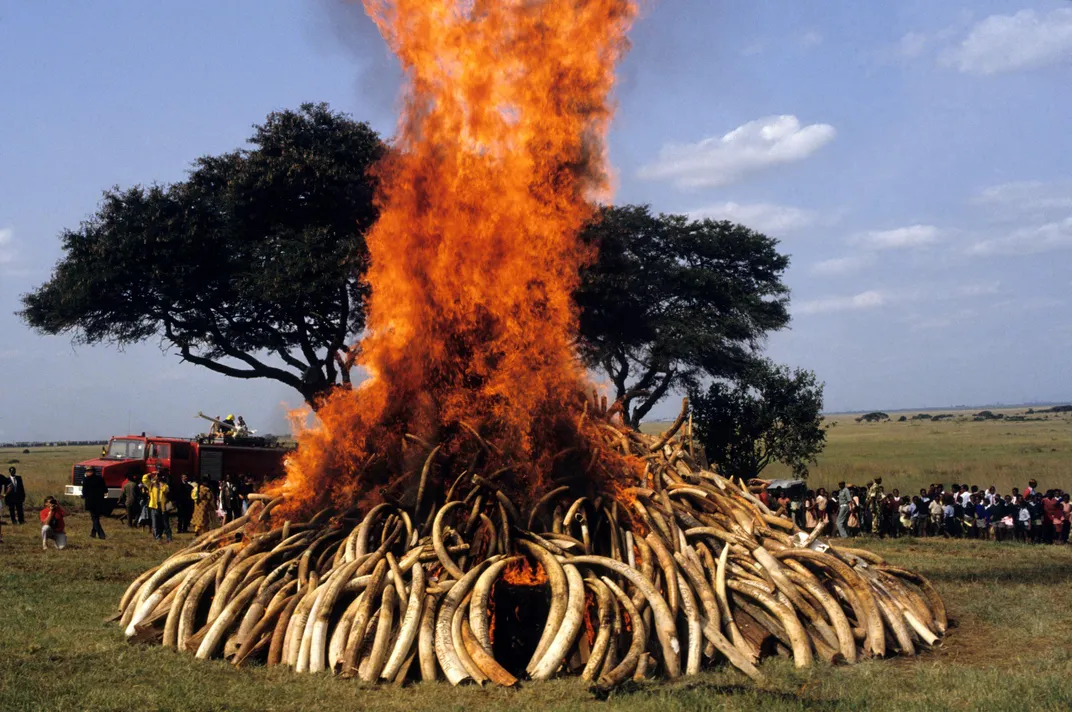Eerie Footage of Over 100 Tons of Burning Ivory
The Kenyan government burned tusks from over 6,000 elephants to reduce stockpiles of ivory and raise awareness of poaching
On Saturday, president of Kenya Uhuru Kenyatta used a torch to set ablaze a giant pyre of ivory, one of 11 similar mounds built in Nairobi National Park that will burn for almost a week. It was part of an effort to incinerate 105 metric tons of elephant ivory and 1.5 tons of rhinoceros horns from the government’s stockpile of confiscated material taken from poachers and illegal traders.
According to Jeffery Gettleman at The New York Times it’s the largest amount of ivory destroyed at one time, representing between 6,000 and 7,000 elephants and $300 million on the black market.
“No one, and I repeat, no one, has any business in trading in ivory, for this trade means death—the death of our elephants and the death of our natural heritage,” president Kenyatta told the gathered crowd.
The burn coincides with a meeting of The Giants Club, a forum that brings together the leaders of nations with elephant populations, business leaders and conservationists to discuss initiatives to help preserve Africa’s elephants, which have seen increased poaching pressure in recent years because of high ivory prices, which can reach $1,000 per kilogram.
Gregory Warner at NPR explains that Kenya has burned ivory since 1989, when it torched 12 tons of elephant tusks. The burning has two purposes. First, it is a public act to show that the government is dedicated to wiping out the ivory trade. Second, it reduces the stock of ivory that the government warehouses.

“If you’re a dealer and you need a ton of ivory, where is the hugest place to go?” Paula Kahumbu, CEO of the conservation group WildlifeDirect, tells Warner. “It’s not to go hunting [elephants]. That’s actually quite risky, to go hunting animals. Actually, if you can raid a stockpile by bribing the guy who has the key, that’s going to be the fastest way that you can get your ivory.”
Not everyone agrees that incinerating the ivory is the best policy. The president of Botswana boycotted the burn, and some conservationists are concerned that the destruction of the ivory will drive up prices, incentivizing poachers to kill more elephants.
According to the BBC, about 30,000 African elephants are slaughtered for their tusks each year. While Kenya has reduced poaching within its borders about 80 percent in recent years, Tanzania, the nation to the south, has lost 65 percent of its elephants in the last five years. Most of the ivory ends up in China, where the material is used to make statuettes, eyeglasses, and other products. Much of it is still shipped through Kenyan ports.
“Kenya is leading the way in saying that ivory has no value, unless it’s on an elephant,” Robin Hollister, an engineer and pyrotechnics expert in charge of burning the ivory tells Warner. The tusks are not particularly flammable, and it takes a mixture of kerosene and diesel squirted into each pile to get them to burn. “Of course, you could destroy ivory by bringing in a stone crusher," he says. "It would be much easier. But it wouldn’t be as dramatic.”

